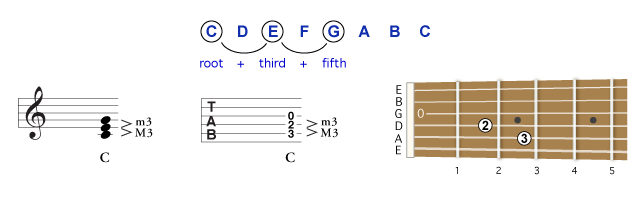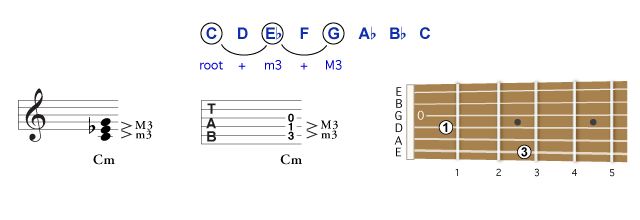As you learn how to play guitar and keyboard, learning basic chord theory will help you become a better player. A musician with a solid understanding of chord theory can use more varied chord voicings for accompaniment and more easily improvise solos and melodies to match a chord progression. Bass players will also use chord theory to create their bass parts.
What is a Chord?
A chord is the simultaneous sounding of three or more notes. Played together, they create what is referred to as harmony. The sound of a chord is based on the relationship of pitches between each of the notes, which are called intervals. Generally the intervals that chords use are the notes found on every other note of a scale. Any chord can be built on any note by using the appropriate formula provided for that particular chord. The notes in a chord are usually played at the same time, but occasionally are played in rapid succession as with arpeggios.
The three broad categories of chords are:
- Triads: major, minor, diminished and augmented.
- Seventh chords (and other four-tone chords): major, minor, diminished, augmented and dominant.
- Extended chords: ninth, eleventh and thirteenth chords: major, minor, diminished, augmented and dominant.
Suspended chords are treated as a special type of chord. All chords can be altered. Note that the octave, which is the same note played higher or lower (e.g., the low E and high E in an E chord), is usually found in chord voicings played on polyphonic instruments like guitar or piano and is not considered a separate interval.
You will find that certain styles of music tend to us particular types of chords and voicings. You can learn much more about guitar chord theory and its applications in eMedia Intermediate Guitar Method, while piano and keyboard players can learn more about chords on their instrument with eMedia Intermediate Piano and Keyboard Method.
Triads
The most common chords are triads. A triad contains three notes commonly built on every other note of a scale. For example, take the C major scale: Begin with the note C and add two more notes in the scale, skipping every other note. The result is a C major triad (C, E, and G). The notes of a triad are numbered from the bottom upward 1, 3, 5. The first note (1) is called the root or tonic. The next note is called the third, and the top note is called the fifth. So for a C chord; the root is C, the third is E and the fifth is a G note.
As shown in the example, the root determines the name of the chord. Although the root is commonly played on the bottom (the lowest note of the chord), sometimes the notes of a chord are rearranged. These chords are called inversions.
Major Chords
A major triad is a chord made up of the root, third, and the fifth of a major scale. In the C major chord, the notes are C, E, and G. The major chord is often abbreviated using the capital letter of the root note — in this case C. When you hear play a C chord,
you are being asked to play a C major chord. Major triads can be built on any note using this formula: root + major third + minor third (root + M3 + m3).
Minor Chords
Minor triads are chords made up of the root, third, and fifth of a natural minor scale. You could also consider it the first, flatted third, and fifth notes of a major scale. The notes of the C minor chord are C, Eb, and G. The abbreviated symbol of a minor chord is the capital letter of the root followed by a smallm
for minor. So, a C minor triad is written Cm. Minor chords can be built on any note using the formula root + minor third + Major third (root + m3 + M3).
Suspended Chords
Suspended chords are chords where one note is eliminated (usually the third) and replaced with another note (usually the fourth or second note of the scale). Suspended chords are abbreviated as sus,
often with a number added to designate the replacement note. The C suspended fourth chord would be written as Csus4.
Seventh Chords
Seventh chords are the most common four-note chords. Like triads, they are built on every other note of a scale, but they have a fourth note:
There are major seventh, minor seventh, diminished seventh, augmented seventh and dominant seventh chords. There is also the seventh chord with a suspended fourth, sometimes called a suspended seventh chord. Any seventh chord can be built on any note using the correct formula.
If you see 7 attached to a chord name (for example, A7), it is a seventh or dominant seventh chord. A7 is the shorthand spelling of the A seventh or A dominant seventh chord. The same rule applies to minor chords. For example, an A minor seventh chord would appear as Am7. The seventh note is the most common color note, used heavily in blues and rock music. If there is a capital M
or a triangle (∆) in front of a number (such as with an AM7
or A∆7
chord), it is a major seventh chord.
Other Chords
Seeing other numbers next to chords (e.g., 6, 9, 11, 13) indicate extended chords that follow the same naming conventions and formula you saw with seventh chords. These chords include the basic notes of the major or minor triads plus one or more color notes. Extended chords are used largely in jazz and some classical music. You can also find the 9th and 7#9 (often called the Hendrix chord, as it was used in popular songs by Jimi Hendrix) used in blues, rock, funk, and pop styles. However, you don’t often see more complex extended chords in these music genres.
A diminished chord is a minor chord with a fifth that is only two and 1/2 steps higher than the root. An augmented chord is a major chord with a fifth that is four whole steps higher than the root.
Using Chord Theory
Each chord has a certain character that composers use to make songs invoke happiness, sadness, tension, and other emotions. Chords are strung together to create chord progressions, and the chord progressions for the basis of songs and other compositions. Another way that chords are used creatively is by using variations on a triad to add color to the chord progression. For example, if a chord progression indicates that you play a C chord for 8 measures, you might play a C for four measures and then a C7 for the second four measures.
To understand all the ways that chord theory can enhance your own playing you should investigate eMedia Intermediate Guitar Method, eMedia Intermediate Piano and Keyboard Method, and eMedia Bass Method. The curriculums were designed by highly qualified, professional teachers. They utilize interactivity to help you identify intervals by ear and teach chord theory to help you improvise solos and enhance your playing.


